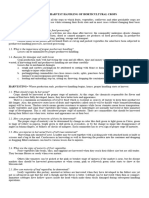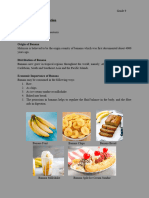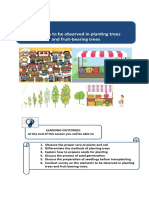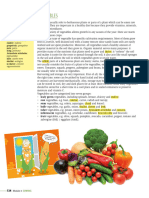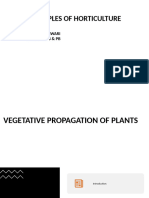Lifecycle of Bananas
Lifecycle of Bananas
Uploaded by
peutilouisCopyright:
Available Formats
Lifecycle of Bananas
Lifecycle of Bananas
Uploaded by
peutilouisOriginal Title
Copyright
Available Formats
Share this document
Did you find this document useful?
Is this content inappropriate?
Copyright:
Available Formats
Lifecycle of Bananas
Lifecycle of Bananas
Uploaded by
peutilouisCopyright:
Available Formats
The life cycle of bananas involves several stages, from planting to fruit production.
Here's a simplified
explanation of the typical life cycle of bananas:
1. Planting: The life cycle begins when banana plants are propagated from the rhizomes
(underground stems) of existing plants. These rhizomes are cut into sections and planted in
well-drained soil. The planting depth ensures that the growing point, known as the "corm," is
covered.
2. Vegetative Growth: Once planted, the banana plants go through a period of vegetative
growth. The corm produces shoots that emerge from the soil. These shoots, known as
suckers, develop into new banana plants. The primary shoot that emerges from the corm is
known as the "sword sucker." As the plant grows, it produces additional suckers, known as
"water suckers." The banana plant's leaves unfurl from the shoot, forming a large and lush
foliage canopy.
3. Pseudostem Development: The shoots grow taller, and the leaf sheaths tightly wrap around
each other, forming a pseudostem that gives the appearance of a trunk. However, this
pseudostem is not a true trunk but a tightly packed aggregation of leaf sheaths. The
pseudostem provides structural support to the plant and serves as a channel for transporting
water and nutrients.
4. Flowering: After a certain period of vegetative growth, the banana plant enters the flowering
stage. A large inflorescence, known as the banana heart or bunch, emerges from the top of
the pseudostem. The banana heart is composed of a central stalk called the rachis,
surrounded by numerous bracts. The bracts protect the developing banana flowers.
5. Fruit Development: The banana flowers within the banana heart undergo pollination and
fertilization. The flowers develop into clusters of bananas called hands. Each hand consists of
multiple individual bananas, known as fingers. The bananas start off small and green and
gradually grow in size and change color as they mature. The maturation process can take
several months depending on the banana variety and growing conditions.
6. Harvesting: Bananas are harvested when they have reached the desired stage of ripeness.
The timing of harvest depends on the intended use of the bananas—whether they are meant
to be consumed fresh or used for processing. The bunch is cut from the pseudostem using
sharp tools. Care is taken to avoid damaging the remaining plants during harvest.
7. Post-Harvest: After harvest, bananas are transported and handled carefully to prevent
bruising and damage. They may undergo a ripening process to reach the desired level of
ripeness, especially for commercial distribution. Bananas are typically stored and transported
in temperature-controlled environments to prolong their shelf life.
8. Utilization: Bananas are widely consumed as a nutritious and delicious fruit. They can be
eaten fresh, added to smoothies, used in baking and cooking, and processed into various
banana products like dried bananas, banana chips, and banana puree. Bananas are also used
as a flavoring in desserts, ice cream, and beverages.
It's important to note that the life cycle of bananas can be influenced by factors such as the banana
variety, climate, soil conditions, and cultivation practices. The cycle typically starts again as new
suckers emerge from the corm, allowing for continuous propagation and fruit production.
You might also like
- Kenworth Wiring Diagrams t4, t6 & t9 Conventional ModelsDocument78 pagesKenworth Wiring Diagrams t4, t6 & t9 Conventional ModelsDavid Fuentes91% (43)
- The Hopper 4X8 PlansDocument22 pagesThe Hopper 4X8 Plansjordannwsp100% (2)
- Optimizing DAX ResourceDocument8 pagesOptimizing DAX ResourceYeyejNo ratings yet
- Project Report On BananaDocument60 pagesProject Report On Bananavrushankhallayrock100% (1)
- CRPT 2 - 3Document5 pagesCRPT 2 - 3Gil Bustilla100% (2)
- The Development of A Banana Plant Is An Interesting Process That Involves Several StagesDocument2 pagesThe Development of A Banana Plant Is An Interesting Process That Involves Several StagesNga PhamNo ratings yet
- Aaua SIWES Report Compiled by OLATUNJI ODocument51 pagesAaua SIWES Report Compiled by OLATUNJI OAyodeleNo ratings yet
- Tropical Landscape ManagementDocument6 pagesTropical Landscape ManagementRafael LlabanNo ratings yet
- Planting MethodsDocument5 pagesPlanting Methodsryan angelo de guzman100% (1)
- Sexual Propagation in PlantsDocument8 pagesSexual Propagation in PlantsSreeja RajNo ratings yet
- Topic 5 - Seed Stru and GermDocument7 pagesTopic 5 - Seed Stru and Germkevingetare50No ratings yet
- Basic Info PHHC 1Document7 pagesBasic Info PHHC 1Ladyliza Martinez NazaroNo ratings yet
- Lesson 6.3Document7 pagesLesson 6.3Binuri SandarekhaNo ratings yet
- Banana CultivationDocument9 pagesBanana Cultivationsiepiner72No ratings yet
- 9.0 Morphology of The Fruit - 1Document23 pages9.0 Morphology of The Fruit - 1nzigeahmedNo ratings yet
- Biology Ss3 Weeks7-9Document7 pagesBiology Ss3 Weeks7-9Oshokeonoso MaizaNo ratings yet
- Chapter 11 - Fruit Growth, Ripening and Post-Harvest PhysiologyDocument50 pagesChapter 11 - Fruit Growth, Ripening and Post-Harvest PhysiologyTikTok ZappingNo ratings yet
- Artificial Vegetative PropagationDocument4 pagesArtificial Vegetative PropagationRainZZaK100% (1)
- Seed Propagatio WPS OfficeDocument5 pagesSeed Propagatio WPS OfficeAkiro SmithNo ratings yet
- SHORT NOTES Chapter 1Document4 pagesSHORT NOTES Chapter 1barikbiswaranjan240No ratings yet
- Plant SystematicsDocument33 pagesPlant Systematicsquratulainamjad56No ratings yet
- Booklet 2 VitiDocument124 pagesBooklet 2 VitiGildaNo ratings yet
- BryophytesDocument5 pagesBryophytesGilbert DullerNo ratings yet
- Week 5Document6 pagesWeek 5mbethwell95No ratings yet
- SeedDocument22 pagesSeedSuporno Purakayastha100% (2)
- AgricultureDocument2 pagesAgriculturevim09480No ratings yet
- S.V.M. Public School AISSCE 2019-20Document34 pagesS.V.M. Public School AISSCE 2019-20Saksham AgarwalNo ratings yet
- Asexual Reproduction - Lesson NotesDocument9 pagesAsexual Reproduction - Lesson NotesabwoyjrNo ratings yet
- Plant PropagationDocument4 pagesPlant PropagationChryselleNo ratings yet
- Cranberry, Lingonberry and Huckleberry: Berries from Ericaceae FamilyFrom EverandCranberry, Lingonberry and Huckleberry: Berries from Ericaceae FamilyNo ratings yet
- Cranberry, Lingonberry, Huckleberry: Berries from Ericaceae FamilyFrom EverandCranberry, Lingonberry, Huckleberry: Berries from Ericaceae FamilyNo ratings yet
- PinappleDocument47 pagesPinappleananiya dawitNo ratings yet
- Dispersal of Seeds by FruitsDocument6 pagesDispersal of Seeds by FruitsAnil PantNo ratings yet
- SEED GERMINATION - ReportDocument5 pagesSEED GERMINATION - ReportpriyanktiwariNo ratings yet
- References: TECHNOLOGY and LIVELIHOOD EDUCATION 8 K-12 Edition Fe S.J. Mangalindan, Et Al. Page 179-186Document2 pagesReferences: TECHNOLOGY and LIVELIHOOD EDUCATION 8 K-12 Edition Fe S.J. Mangalindan, Et Al. Page 179-186eldrich balinbinNo ratings yet
- Class V Science Chapter 1 Long Answer Question SolutionDocument3 pagesClass V Science Chapter 1 Long Answer Question SolutionAnanya ChakrabortyNo ratings yet
- Banana (Musa) : Uses and ImportanceDocument7 pagesBanana (Musa) : Uses and ImportancerihrihhhNo ratings yet
- Propagation Methods in PlantsDocument36 pagesPropagation Methods in PlantsThea PadlanNo ratings yet
- Introduction To HorticultureDocument26 pagesIntroduction To HorticultureGino R. MonteloyolaNo ratings yet
- g12 Biology Lesson Notes-2024Document13 pagesg12 Biology Lesson Notes-2024mwashikakNo ratings yet
- Lesson 2Document11 pagesLesson 2christopher palacioNo ratings yet
- Chapter 6 Types of Tissue CultureDocument129 pagesChapter 6 Types of Tissue Culturerajiv pathakNo ratings yet
- New Agriways PreviewDocument2 pagesNew Agriways Previewmohammadibraheem8620No ratings yet
- How To Grow Ground Cherries ( Physalis SPP.) : Frost CalendarDocument2 pagesHow To Grow Ground Cherries ( Physalis SPP.) : Frost CalendarKCMG FoundationNo ratings yet
- Determining The Best Growing Seeds G5Document15 pagesDetermining The Best Growing Seeds G5Deasserei TatelNo ratings yet
- 1.8 The Life Cycle of A Flowering PlantDocument2 pages1.8 The Life Cycle of A Flowering Plantnavya kommareddyNo ratings yet
- Lesson 6 LO5 - Lesson Information 5.1Document13 pagesLesson 6 LO5 - Lesson Information 5.1It's me zafra blogsNo ratings yet
- SEEDDocument15 pagesSEEDchrolo crossNo ratings yet
- GerminationDocument2 pagesGerminationJelbert HermosaNo ratings yet
- Mahogani PlantationDocument21 pagesMahogani Plantationfox mNo ratings yet
- Viticulture ManualDocument66 pagesViticulture Manualpanaglaw100% (2)
- Mango Pro. HandoutsDocument15 pagesMango Pro. HandoutsKristine Jenyl PacificoNo ratings yet
- Vertevrates InvertebratesDocument7 pagesVertevrates InvertebratesPugyao Reyes ChonaNo ratings yet
- Lesson Plan Biology 6th ClassDocument4 pagesLesson Plan Biology 6th ClassManju kotturNo ratings yet
- Presentation PGDocument41 pagesPresentation PGSundar RagavanNo ratings yet
- 2nd Quarter Lessons 2.0Document97 pages2nd Quarter Lessons 2.0Jean Zyrelle AuronNo ratings yet
- Grow Strawberries at Home: The complete guide to growing strawberries in your backyard!From EverandGrow Strawberries at Home: The complete guide to growing strawberries in your backyard!Rating: 5 out of 5 stars5/5 (1)
- Plant Propagation and Breeding in AgricultureDocument8 pagesPlant Propagation and Breeding in Agriculturessegawaedward10No ratings yet
- Unit 1 Agri 116 NotesDocument8 pagesUnit 1 Agri 116 NotesVreen Pietro Mari EstimoNo ratings yet
- BananaDocument25 pagesBananaDomagoj ButumovićNo ratings yet
- Cucumber (Cucumis Sativus) : Prepared By: Darlene Mae D. TalagtagDocument7 pagesCucumber (Cucumis Sativus) : Prepared By: Darlene Mae D. TalagtagPETER PAUL ESTILLERNo ratings yet
- Class 10 How Do Organisms ReproduceDocument19 pagesClass 10 How Do Organisms ReproduceniranjannandkishoregiriNo ratings yet
- 03 - REIT - May 27Document4 pages03 - REIT - May 27MAUREEN BAN-EGNo ratings yet
- ReSPR3001 PDFDocument2 pagesReSPR3001 PDFshyamchepurNo ratings yet
- Lunar Wireless Power Transfer Feasibility Study: March 2008Document36 pagesLunar Wireless Power Transfer Feasibility Study: March 2008Nikhil ReddyNo ratings yet
- Discrete MathematicsDocument23 pagesDiscrete MathematicsccchengchuuuNo ratings yet
- Ug903 Vivado Using ConstraintsDocument152 pagesUg903 Vivado Using ConstraintsJenniferNo ratings yet
- Acccob 2 Portfolio: Reflection Paper Presented To The Accountancy DepartmentDocument6 pagesAcccob 2 Portfolio: Reflection Paper Presented To The Accountancy DepartmentRafael CaparasNo ratings yet
- Ashland Resin Guide Final 07-11.rdDocument24 pagesAshland Resin Guide Final 07-11.rdPublitNo ratings yet
- TKT Clil HandbookDocument30 pagesTKT Clil HandbookWawa ChenNo ratings yet
- Swinging CircleDocument2 pagesSwinging CircleNarayana Reddy100% (1)
- E BusinessDocument336 pagesE BusinessMainak SenNo ratings yet
- Factsheet 210129 36 IdxinfraDocument1 pageFactsheet 210129 36 IdxinfraNeedlaregNo ratings yet
- Appendices Performance ManagementDocument15 pagesAppendices Performance ManagementBrunoAndrade0% (2)
- Cummins (2002) - A Model of SWB HomeostasisDocument40 pagesCummins (2002) - A Model of SWB HomeostasisAmalia NurlinaNo ratings yet
- G2 - Coastal Activities Offered by Tondol Beach in Anda, PangasinanDocument58 pagesG2 - Coastal Activities Offered by Tondol Beach in Anda, Pangasinaneuniceclaudio17No ratings yet
- Awaken The Giant Within2Document9 pagesAwaken The Giant Within2juan72100% (2)
- Far Eastern University My Curriculum Institute of Arts and SciencesDocument3 pagesFar Eastern University My Curriculum Institute of Arts and SciencesUriel SarmientoNo ratings yet
- Agile DevelopmentDocument31 pagesAgile Developmentbright.keswaniNo ratings yet
- Group 2 Project ReportDocument70 pagesGroup 2 Project ReportBijaya RaulaNo ratings yet
- Bridge PlacementDocument25 pagesBridge PlacementJoe la dassNo ratings yet
- Welcome To Crystal Hunters!: Japanese Writing SystemsDocument45 pagesWelcome To Crystal Hunters!: Japanese Writing SystemsbobNo ratings yet
- Screwguard Rotair Altair: People. Passion. PerformanceDocument4 pagesScrewguard Rotair Altair: People. Passion. PerformanceAristideNo ratings yet
- Module 5 Final AssignmentDocument12 pagesModule 5 Final Assignmentrenataibe8No ratings yet
- KTR Kat99pp01 Coupling GuardDocument20 pagesKTR Kat99pp01 Coupling Guardmoorthymech1979100% (1)
- FortiSandbox-4 2 3-Administration - GuideDocument238 pagesFortiSandbox-4 2 3-Administration - GuideForTest TestForeNo ratings yet
- Golgi-Cox Staining Protocol For Neurons and Processes: Novaultra Special Stain KitsDocument3 pagesGolgi-Cox Staining Protocol For Neurons and Processes: Novaultra Special Stain KitstetrazolamNo ratings yet
- Islami Social Studies Lesson Plan-2Document4 pagesIslami Social Studies Lesson Plan-2api-607132776No ratings yet
- Optocoupler Input Drive CircuitsDocument7 pagesOptocoupler Input Drive CircuitsLuis Armando Reyes Cardoso100% (1)











